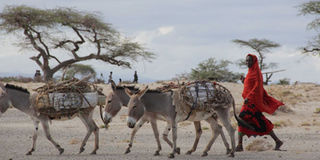Breaking News: At least 10 feared to have drowned in Makueni river
Donkey milk? UN food agency says yes to counter high milk prices

A woman drives her three donkeys home after collecting firewood at North Horr area in Marsabit county on November 4, 2013. The UN food agency is recommending more usage of milk from a variety of animals including donkeys, camels and llamas to counteract high cow milk prices. Photo/ JOSEPH KANYI
The UN food agency is recommending more usage of milk from a variety of animals including donkeys, camels and llamas to counteract high cow milk prices due to growing demand for dairy in the developing world.
"There is huge scope for developing other dairy species," Anthony Bennett, livestock industry officer at the United Nations Food and Agriculture Organisation (FAO) in Rome, was quoted as saying in a statement.
In a report co-authored by Bennett released Tuesday, the FAO said that alpaca, donkeys, moose, reindeer and yak could also be milked, alongside other species that are already used for milk like buffalo, goat and sheep.
It said reindeer and moose milk was high in fat and protein and also contained half the lactose found in cow milk, making it a possible alternative source of dairy for people with lactose intolerance.
The report forecast that dairy consumption in developing countries will grow by 25 per cent by 2025 as a result of population growth and rising incomes.
But it said that milk -- a crucial source of dietary energy, protein and fat -- "will likely still be out of reach for the most vulnerable households".
"Governments need to address the issue by making nutrition a specific objective in dairy sector development and by investing in programmes that help poor families keep small dairy livestock," it said.
Alpaca and llama and alpaca breeding could provide "a valuable nutritional and economic resource" for people in mountainous areas of South America, it said.
The FAO pointed out that camel milk is already prized in Ethiopia, Mali and Somalia and mare's milk is consumed by 30 million people in Russia and Central Asia.





